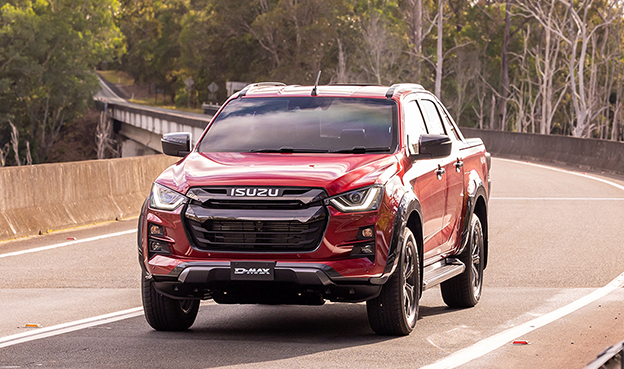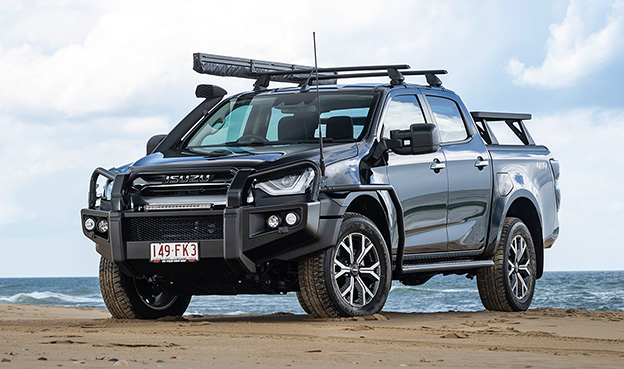


What is trailer sway?
Also called ‘fishtailing’, trailer sway happens when your van or trailer swings from side to side. Any trailer towed with a hitch set behind the rear axle of the tow vehicle can be susceptible. Very dangerous, it’s more than capable of taking you off the road.
Good news: it’s largely avoidable
Environmental factors can contribute to the sway, such as a day of high side winds, where the buffeting gets a rhythm going and you become an unwilling dance partner. At other times, it’s an inexperienced driver dropping the verge-side wheels onto the dirt, then over-correcting. Too often, though, it’s due to overloading or poor weight placement coupled with under or over-inflation of your tyres. You can nip this in the bud.
Know your numbers
Isuzu designs its vehicles with a maximum payload in mind that is then combined with the weight of your van or trailer. This is called GCM, or gross combination mass. On a D-MAX or an MU-X that’s very nearly six tonnes of tow vehicle, trailer or van and everything else you’ve packed in. One of the biggest mistakes folk make is buying the biggest caravan they can get—you know, the tandem off-road kind that makes their tow vehicle look like a toy. The van is already near the maximum tow weight—maybe three tonnes—but then they load up with a bull bar, long-range fuel tank, tinny, fridge and more. Add passengers and the effect of towball downforce, and you’ve bumped up against the Gross Vehicle Mass (GVM) of the 4WD. With the suspension and tyres approaching their limits too, warning bells should now be ringing loudly! Visit a public weighbridge in this instance to get your figures straight.
“ENVIRONMENTAL FACTORS CAN CONTRIBUTE, SUCH AS A DAY OF HIGH SIDE WINDS, WHERE THE BUFFETING GETS A RHYTHM GOING AND YOU BECOME AN UNWILLING DANCE PARTNER.”
Now you’re balanced
So you’re under the GCM threshold and you’ve set your tyre pressure to what’s recommended for a big load. You’ll have the optimum balance going provided the towball downforce* is within spec (that’s 350kg max for D-MAX and 300kg max with MU-X) and the rear tyres aren’t overloaded. Don’t try to balance out excessive downforce using weight distribution hitches or airbags— weight is the enemy—and be sure you’ve followed the maximum load/pressure requirements, which your caravan manufacturer will prescribe. This will be based on a load carried per tyre; pressure and load are intrinsically linked.
*When using a Genuine Isuzu UTE tow kit
Beware the B-double
Watch out for that oncoming semi as you’re punching 100km/h up the highway. As you pass with a combined speed of 200km/h, the moment results in a low pressure event that draws vehicles together. There’ll be some instability, horrifyingly, so if your sums were wrong the tail may wag.

Them’s the (electric) brakes
If you have an electric brake controller, you’ll know that there’s a button or slide control that in this instance can be applied to activate the trailer’s brakes only. In effect, this ‘stretches’ the tow combo back to a safe straight line—but you might not think of this in the heat of that moment. That ‘stretch’ moment is important. When you’re driving and your foot is on the accelerator, it has an effect similar to ‘stretching’ the vehicles. Going downhill on a trailing accelerator unloads the vehicles and can have an unwanted effect in inducing sway. In a modern vehicle, dynamic electronics are ready to pounce on a situation when this occurs. ESC or Electronic Stability Control is one of them, detecting ‘yaw’ moments (that’s the sway) and offering up corrective brake inputs irrespective of what you’re doing. Some caravan makers now have ESC installed on their vans for the very same reason.
Can you steer your way out of it? Maybe—just don’t panic.
If you catch trailer sway early enough a gentle initial application of the brake, with progressive intensity coupled to a similarly gentle corrective steering input, will likely save the day. On the other hand, I know of worst-case situations in which drivers have panicked, using big corrective steering inputs and smashing the brake pedal, resulting in a nasty jackknife or rollover. The main thing to remember is that that no two situations will ever be alike, so be prepared, know your load ratings and keep in mind that it’s always better to be safe than sorry. Touring Australia with a van, trailer or boat on the back is an institution that’s guaranteed fun—no matter your age. Make sure you do it safely and you’ll be lapping the world’s best continent for years to come.





